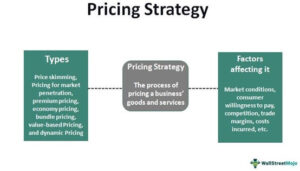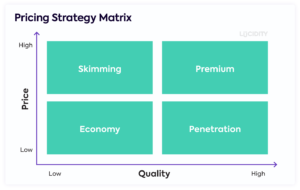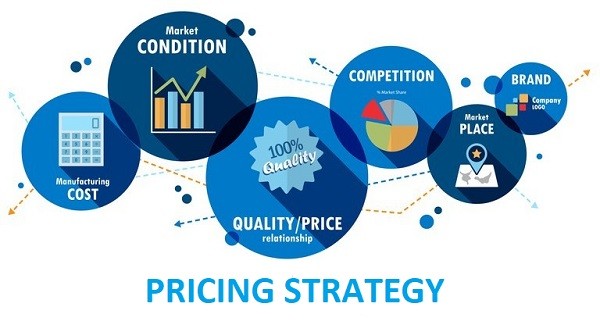Crafting the perfect price for your product can feel like an alchemical formula. You want to attract customers with competitive offerings while ensuring your business thrives. This guide explores the world of pricing, what it is, why it matters, the various pricing strategies, and how to choose the approach that aligns best with your business goals.
What is pricing?
Simply put, pricing is the process of determining the value a customer will pay for your product or service. It’s the price tag you put on the benefits and solutions you offer. Effective pricing considers several factors, including:
- Cost of production: This includes the cost of materials, labor, and any other expenses associated with creating your product or service.
- Target market: Understanding your ideal customer’s price sensitivity and willingness to pay is crucial.
- Competitor pricing: Knowing what your competitors charge for similar offerings helps you position your product competitively.
- Value proposition: The perceived value your product or service offers to the customer is a key factor in justifying your price point.
What is a pricing strategy?
A pricing strategy is a well-defined approach to setting the prices for your products or services. It goes beyond simply picking random numbers and involves careful consideration of various factors. A well-developed pricing strategy should be:

- Customer-centric: Focus on the value your offering brings to the customer and the price they’re willing to pay for that value.
- Competitive: Be aware of your competitors’ pricing strategies and position your pricing accordingly.
- Profitable: Ensure your prices cover your costs and generate a healthy profit margin.
- Scalable: Your pricing strategy should be adaptable to accommodate future growth and market changes.
Why is pricing strategy important?
Crafting a solid pricing strategy is essential for your business success for several reasons:
- Maximizes profits: Effective pricing helps you strike a balance between generating revenue and ensuring affordability for your target market.
- Boosts sales and conversions: The right price point can entice customers to buy and convert, leading to increased sales.
- Contributes to brand perception: Pricing can influence how customers perceive your brand. Premium pricing can convey high quality, while budget-friendly options position you as accessible.
- Provides a competitive advantage: A strategic pricing approach can differentiate you from competitors and attract customers seeking value.
Top 8 pricing strategies
-
Cost-plus pricing
This is the most straightforward strategy, where you add a markup percentage to your total product cost to arrive at your selling price.
Calculation:
Selling Price = Total Product Cost + (Total Product Cost x Markup Percentage)
Example:
- Imagine a handmade scarf incurs $10 in materials and manufacturing costs.
- You decide on a 50% markup to cover overhead costs and generate a profit.
Selling Price = $10 (Cost) + ($10 x 50%) = $15
Pros:
- Easy to implement
- Ensures you cover your basic costs
Cons:
- Doesn’t consider market demand or competitor pricing
- May lead to overpriced products if the markup is too high
-
Competitive pricing
Here, you set your prices based on what your competitors are charging for similar products.
Calculation:
This strategy doesn’t involve a specific formula. You’ll need to research competitor pricing and position your product accordingly.
Example:
- You discover similar handmade scarves on competitor websites priced between $12 and $18.
Options:
- Price your scarf competitively within this range (e.g., $15) to attract customers familiar with the market value.
- Offer a slightly lower price (e.g., $14) to undercut competitors and gain a competitive edge.
Pros:
- Reduces customer sticker shock by aligning with market expectations
- Helps you stay competitive in a crowded marketplace
Cons:
- May lead to price wars, squeezing your profit margins
- Doesn’t leverage your product’s unique value proposition
-
Value-based pricing
This strategy focuses on the perceived value your product offers to customers, not just its production cost.
Calculation:
There’s no single formula, but consider these factors:
Unique features and benefits: What problem does your product solve or what need does it address?
Target customer: How much would your ideal customer be willing to pay for the value your product delivers?
Market research: Are there similar products with a premium price point due to perceived value?
Example:
- Your handmade scarf is made from ethically sourced, organic materials and features a unique, hand-embroidered design.
Options:
- Position your scarf as a premium product based on its ethical sourcing, quality materials, and unique design.
- Price it competitively within the premium scarf market (e.g., $30-$40)
Pros:
- Allows you to capture a higher profit margin if your product offers superior value
- Builds brand perception and attracts customers who appreciate quality
Cons:
- Requires a strong understanding of your target customer’s value perception
- May price out budget-conscious customers
-
Penetration pricing
This strategy involves setting a lower introductory price to attract new customers and gain market share.
Calculation:
Selling Price = Target Price (your ideal long-term price) – Discount Rate
Example:
- You’re launching your handmade scarf line and want to generate initial buzz. Your target price is $20, but you decide to offer a 20% discount for the first month.
Selling Price = $20 (Target Price) – (20% x $20) = $16
Pros:
- Creates a sense of urgency and drives initial sales
- Helps you establish brand awareness among new customers
Cons:
- May train customers to expect lower prices in the future
- Can be difficult to raise prices later without alienating customers
-
Premium Pricing
This strategy positions your product as a high-end, luxury item, often associated with exclusivity and status.
Calculation:
There’s no set formula, but consider factors like:
High-quality materials and craftsmanship
Unique design or brand reputation
Limited availability or exclusivity
Example:
- Your handmade scarves are crafted from rare, high-quality fibers and boast intricate, hand-painted designs.
Options:
- Price your scarves at a premium price point reflecting the exclusivity and superior quality (e.g., $50+)
Pros:
- Commands a higher profit margin
- Creates a perception of luxury and desirability
- Can attract a loyal customer base who value exclusivity
Cons:
- Limits your customer reach to a smaller, high-end market
- Requires a strong brand reputation to justify the higher price point
-
Bundle pricing
Bundle pricing leverages the psychology of customer preference for deals and creates a perception of increased value. Here’s how it works:
- Combine Products: Group complementary products together into a bundle. For example, a clothing store might bundle a scarf, hat, and pair of gloves as a winter accessory set.
Calculation:
There are two common approaches:
Discounted Bundle Price: Set a lower price for the bundle compared to buying each item separately. This can be achieved through a flat discount or a percentage off.
-
- Example: A scarf sells for $20, hat for $15, and gloves for $10. You might offer a winter accessory bundle for $40 (25% discount).
Tiered Bundles: Offer different bundle options with varying price points and product combinations.
-
-
- Example: A basic bundle with just the scarf and hat for $30, and a premium bundle with all three items for $45.
-
Pros:
- Increases average order value by encouraging customers to purchase more products.
- Clears out slow-moving inventory by bundling them with popular items.
- Creates a sense of urgency and drives sales with limited-time bundle offers.
Cons:
- Requires careful product selection to ensure the bundle offers genuine value.
- May not be suitable for all products (bulky items or high-priced products might not bundle well).
-
Freemium model
The freemium model provides a basic version of your product or service for free, alongside a premium version with more features or functionality at a higher price point. This strategy is particularly effective for:
- Software and SaaS products: Offer a limited free version with basic functionality to showcase your product’s value and entice users to upgrade to the premium plan for advanced features.
Calculation:
There’s no set formula, but consider:
Free version features: Include enough features to be valuable but not enough to replace the need for the premium version.
Premium version features: Offer significant value upgrades that justify the additional cost (e.g., increased storage, advanced analytics, etc.).
Pros:
- Acquires a large user base by offering a free entry point.
- Converts free users to paying customers by demonstrating the premium value proposition.
- Generates recurring revenue through premium subscriptions.
Cons:
- Requires ongoing development to maintain both the free and premium versions.
- There’s a risk that some users may be content with the free version and never upgrade.
-
Dynamic pricing
Dynamic pricing allows you to adjust your prices automatically based on real-time market data. This can be particularly beneficial for:
- Ecommerce businesses with a large product catalog: Dynamic pricing helps ensure you’re competitively priced across all your offerings.
- Products with fluctuating demand: Increase prices during peak demand periods (holidays) and lower them during slow seasons.
Calculation:
Advanced tools and algorithms are required to analyze factors like:
Demand: Automatically adjust prices based on real-time customer demand.
Competitor pricing: Monitor competitor pricing and adjust your prices accordingly to stay competitive.
Inventory levels: Increase prices for low-stock items to create a sense of scarcity or decrease prices for overstocked items to clear inventory.
Pros:
- Maximizes profit potential by capturing fluctuations in demand.
- Maintains a competitive edge by dynamically adjusting prices to market conditions.
- Optimizes inventory management by preventing overstocking or lost sales due to understocking.
Cons:
- Requires investment in sophisticated pricing software and data analysis expertise.
- Can be perceived as unfair or unreliable by customers if not implemented strategically.
- May require clear communication to customers about the rationale behind dynamic pricing changes.
Choosing the right strategy
The optimal pricing strategy depends on your unique business goals, target market, and product characteristics. Here are some factors to consider when making your choice:
- Product lifecycle stage: Are you launching a new product (penetration pricing) or a well-established one (value-based pricing)?
- Profit margin goals: Do you prioritize rapid growth (lower prices) or maximizing profitability (higher margins)?
- Brand positioning: Are you building a budget-friendly brand (competitive pricing) or a luxury brand (premium pricing)?
How to create your pricing strategy?

Developing a successful pricing strategy involves a series of steps:
- Define your target market: Who are you selling to? Understanding their demographics, needs, and buying behavior is crucial.
- Analyze your costs: Calculate all the costs associated with producing and delivering your product or service.
- Research your competitors: Analyze what your competitors charge for similar products or services.
- Determine your value proposition: Identify the unique benefits and value your offering provides to customers.
- Choose a pricing model: Select a pricing model that aligns with your product, target market, and business goals. Common models include cost-plus pricing, value-based pricing, competitive pricing, and freemium models.
- Test and refine: Don’t be afraid to test different price points and analyze the results. Adapt your strategy based on customer response and market conditions.
Industry differences in pricing strategy:
The ideal pricing strategy can vary depending on your industry. Here are some examples:
- Retail: Retailers often employ competitive pricing and frequently run sales and promotions to attract customers.
- Software-as-a-Service (SaaS): SaaS companies might offer freemium models with limited features alongside paid subscriptions for advanced functionalities.
- Luxury goods: Luxury brands often utilize premium pricing to create an image of exclusivity and high quality.
3 real-world pricing strategy examples:
- Netflix: Netflix uses a subscription-based pricing model with different tiers offering varying content libraries. This caters to different customer budgets and viewing habits.
- Amazon prime: Amazon Prime utilizes a membership model that offers free shipping, exclusive deals, and access to streaming services. This encourages customers to sign up for a recurring membership fee.
- Dollar shave club: Dollar Shave Club uses a subscription-based model with a low introductory price to entice customers and then lock them into a recurring subscription for ongoing revenue.
Pricing strategy FAQs:
- Q: Do I need to change my pricing strategy over time?
A: Yes, your pricing strategy should be adaptable. As your business grows, market conditions change, and you gain customer insights, you may need to adjust your pricing accordingly.
- Q: Should I always offer discounts and promotions?
A: Not necessarily. Discounts and promotions can be effective tools to attract new customers, clear out old inventory, or boost sales during slow periods. However, overuse of discounts can erode your brand value and profit margins. It’s best to use them strategically and ensure they contribute to your overall pricing strategy.
- Q: How can I track the effectiveness of my pricing strategy?
A: Monitor key metrics like sales volume, conversion rate, customer acquisition cost (CAC), and customer lifetime value (CLTV). This data will help you gauge whether your pricing strategy is driving sales and generating healthy profits.
Q: What are some common pricing mistakes to avoid?
A: Here are some pitfalls to be aware of:
Underpricing: Pricing your product or service too low can lead to lower profit margins and potentially devalue your brand.
Overpricing: Setting prices too high can deter customers and make it difficult to compete.
Ignoring customer value: Focusing solely on cost or competitor pricing without considering the value proposition to the customer can lead to an ineffective strategy.
Not being flexible: Being too rigid with your pricing can limit your ability to adapt to market changes and customer needs.
Q: Where can I find additional resources on developing a pricing strategy?
A: Here are some helpful resources:
HubSpot pricing guide:http://[https://blog.hubspot.com/sales/pricing-strategy]
Forbes: How to develop a winning pricing strategy:
Price intelligently: http://[https://twitter.com/priceintel?lang=en] (https://twitter.com/priceintel?lang=en) (website offering pricing strategy resources)
Conclusion
Don’t be afraid to experiment with different pricing strategies to see what resonates best with your target audience. Carefully track your sales data and customer behavior to analyze the effectiveness of your chosen approach. By continuously testing, refining, and adapting your pricing strategy, you can ensure it remains a powerful tool for driving sales, profitability, and long-term success in the ever-evolving world of ecommerce.
